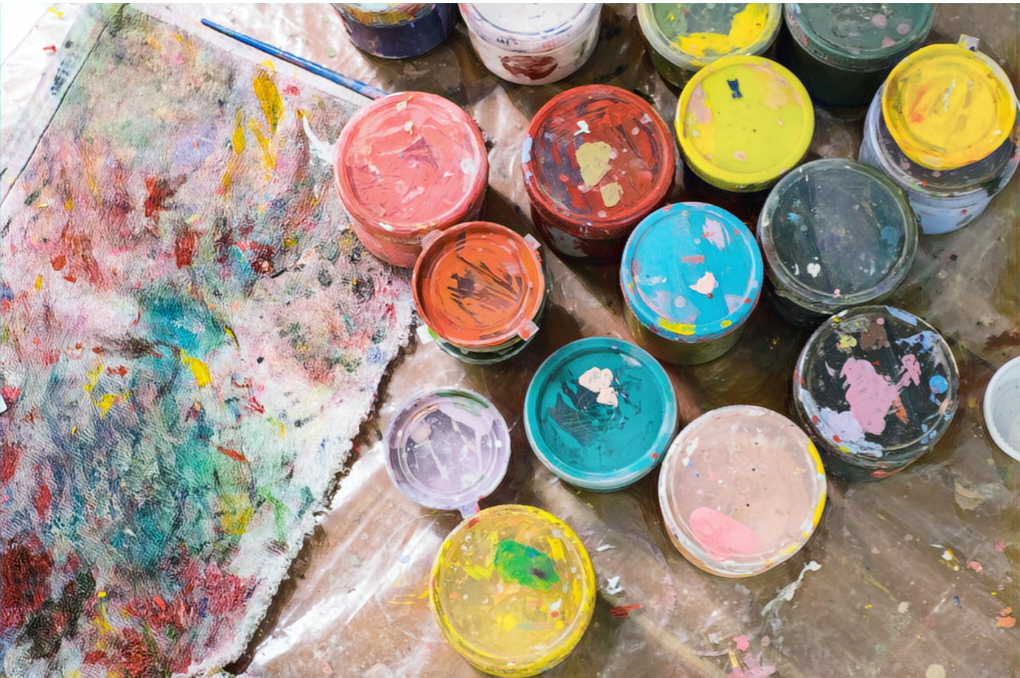Setting Up Your Creative Space

Setting Up Your Creative Space
Are you ready to set up your creative space? Are you feeling inspired to get started on an Art4Healing® class and wondering what supplies you’ll need? Do you also have kids that might like to try the Art for Kids classes too? Wondering what supplies they’ll need and how to set up their art space? I will help you figure all that out and give you suggestions for creating an art area in your home to support yourself and your family in setting up your creative routines to do both art for fun and art for healing.
Taking an Art4Healing® class in your home
The most important thing to know about setting up a space to do your Art4Healing® class is that you truly must have privacy for you to get the most out of the lesson. This is an appointment with yourself so schedule it for when you can create this private time for yourself—experiment with how to do this if you have young children. Get up an hour or so earlier or put the kids to bed earlier and ask for an hour free from your spouse. Find a quiet spot where you will ideally not be interrupted. I am 100% serious about this. You deserve this time, so get creative and figure out a way to make it happen!
Art4Healing® Class Supply List:
- A Set of Acrylic Paint – 9 tubes needed: Red, Orange, Yellow, Green Blue, Violet, Black, White, Brown
https://www.amazon.com/s?k=acrylic+paint+set-ROYGBV&ref=lv_vv_lig_pab - Canvas Boards -9 x 12″, 11 x 14″, 4 x 6″ ideally, but any size you like is OK. (canvas boards are less expensive than stretched canvases)
https://www.amazon.com/s?k=canvas+boards-+9+x+12%22%2C+11+x+14%22%2C+4+x+6%22&ref=lv_vv_lig_pab - Bag of Latex-free wedge sponges (we use dense latex-free wedge sponges as our brushes along with Q-Tips)
https://www.amazon.com/s?k=Bag+of+latex+free+wedge+sponges&ref=lv_vv_lig_pab - Pack of Cotton Swabs (Any brand of Q-Tip-like swabs are okay)
https://www.amazon.com/s?k=pack+of+cotton+swabs&ref=lv_vv_lig_pab - Large 10″ Foam Plate (Large foam plates make a great paint palette)
https://www.amazon.com/s?k=large+10%22+foam+plates+as+palette&ref=lv_vv_lig_pab - Small Foam Plates for Mixing Paint (Small foam plates are great as a mixing tray)
https://www.amazon.com/s?k=small+foam+plates+for+mixing&ref=lv_vv_lig_pab - Small Water Cups (Cup for water is needed for each class)
https://www.amazon.com/s?k=small+water+cups&ref=lv_vv_lig_pab - White copy paper (1 sheet per class needed for warm-up)
https://www.amazon.com/s?k=white+copy+paper&ref=lv_vv_lig_pab
Paint Kit Available
There is also a paint kit online that you could purchase that comes with 12 tubes of acrylic paint and canvases for around $15 – $18 (I’ve seen the price fluctuate on this kit.)
If you bought this kit, you would only need to get the sponges and Q-tips, and a few other supplies. Here is the Amazon link to the paint kit: https://www.amazon.com/Acrylic-Paint-Kids-Artists-Adults/dp/B0861FN3BK/ref=sr_1_6?
Please use what supplies you already have. The above links are just to show you the kind of thing we are looking for. You can get creative and make substitutions where you see fit, but please make sure to have the Foam Sponges and Q-Tips! Those are really important to the Art4Healing® process. We don’t use paintbrushes in Art4Healing® classes!
Another suggestion: If you do not want to use the canvas boards, you could purchase a pad of Acrylic paper like this: https://www.amazon.com/Canson-Acrylic-Canvas-Texture-Sheets/dp/B010BUB930/ref=sr_1_4?dchild=1&keywords=acrylic+painting+paper+pad&qid=1621213276&s=arts-crafts&sr=1-4
Although not required, a tabletop easel can be really helpful while painting. If you buy one, keep in mind the size of the canvas board or acrylic paper you’re choosing to ensure that the easel can support it. Here are some suggestions on Amazon: https://www.amazon.com/s?k=tabletop+easel&i=arts-crafts&crid=2OZL8BZIWXUAJ&sprefix=table%2Carts-crafts%2C179&ref=nb_sb_ss_ts-doa-p_1_5
I have this one, and it came with paint, a pad of acrylic paper, and 3 canvas boards: https://www.amazon.com/gp/product/B07HH2N423/ref=ppx_yo_dt_b_search_asin_title?ie=UTF8&psc=1
Feel free to ask me any questions but remember to use what you have around the house for most items to cut down on costs.
Make Your Art Supplies Accessible
A key for setting up your creative art space at home would be making your art supplies easily accessible. I would suggest creating an area to store most of your Art4Healing® supplies where they will be easily to grab to use regularly near where you’ll be working. Hunting for supplies is no fun when you’re ready to paint and don’t have much time. Maybe you can set aside a couple of shelves on a bookcase and store your Art4Healing® supplies in a pretty fabric storage bin. Under the bed storage bins can work well too.
Creating an Inspiring Space for Yourself
Create an inspiring space for yourself. Make sure you have a work surface to paint with good lighting nearby. Maybe you can also light a candle for a special touch. (I like the battery-operated ones as they aren’t a fire hazard.) You can play some very soft classical music or other relaxing music (music without words, please) while you’re painting. Maybe turn on an essential oil diffuser with a pleasing, relaxing scent. Think about the ambiance you’d like to create for your healing space. Perhaps keep your journal and a nice pen nearby for time to write and reflect after your class. So you can write about what you discovered about yourself during your Art4Healing® class and about how you are feeling. Give yourself that time for reflection afterward if you can before cleaning up and getting on with your busy life again.
Where will you put your pieces after they dry? Maybe some pieces you’ll not want to look at again, and perhaps some you will. Maybe you don’t have extra time to do anything other than paint, and that’s perfectly fine too. Make it work for you, and just be open and present to the painting process.
Doing Art4Healing® Classes With Your Kids
If you are doing an Art4Healing® class with your kids, you can watch the class first to ensure the questions are appropriate for their age or situation. Thousands of children have taken Art4Healing courses over the past 20 years with great success. As the parent, you decide which Art4Healing courses best suit your child. Your setup will need to fit more people, so you may be in an open room at a dining room table. Just try and make sure there are no big distractions for your time painting together, just as you would if you were painting by yourself.
Afterward, perhaps you can ask your children how they liked the experience of painting and if they’d like to do it again. Maybe ask if they’d like to share anything about what they painted.
Questions You Can Ask Your Kids After Taking an Art4Healing® Class:
- Which parts were the easiest parts to paint?
- Which parts were more difficult to paint?
- What did they like about painting?
- What did they not like about painting?
- Is there anything you’d like to share about your painting?
Remember that these classes are all about personal self-expression and privacy in what you paint, so I would respect their privacy if they don’t wish to share. Not probing too deeply with questions can help them enjoy the Art4Healing® painting process and make them want to do it again.
Supplies for the Art for Kids classes will change according to the month’s lessons, and you will be notified of product suggestions with shopping links.
For the Art for Kids art lessons, I would suggest doing the same thing that you would do for yourself for your own creative project or Art4Healing® class preparation.
Organize Your Supplies for Ease of Use
Organize your supplies for ease of use. Have bins prepared with the kids’ art supplies easily accessible near a place to draw. Maybe on a bookcase near the dining room table, for example. Or stored in a buffet or kitchen island if you have one near. Again, if space is tight, you can store your supplies under the bed roll-out plastic organizer you bring near your space when you work. Make sure you have good lighting and water for clean-up nearby. You can use newspapers or even a shower curtain liner to cover your table for messier painting projects. Maybe have some baby wipes ready to wipe hands during painting. Do you have an area to store their work as it dries? What about a place to show off your child’s creations?
You can put on some relaxing music. Make sure the kids are comfy. You can relax together and read art books related to the lesson before or after they create their art.
Celebrate and Display Your Kids’ Artwork
I have a Private Facebook Group where you can upload your child’s artwork for recognition, but I also suggest putting it up in the house where everyone can enjoy it. Put their artwork on the fridge or on a bookshelf. Hang it on the wall in one of those changeable artwork frames. Or a really fun way to display their artwork is to attach it to clothespins on a string across the wall for an instant art gallery. Just get it up on display!
You can also use online websites to digitally save their artwork. Some websites I like are:
- Plum Print: https://www.plumprint.com/
- Artkive: https://www.artkiveapp.com/
- Shutterfly: https://www.shutterfly.com/photo-books/flush-mount-styles/kids-book-of-art-photo-book
- Mixbook: https://www.mixbook.com/kids-photo-books/arts-and-crafts-3502?ptid=6443
You can scan or photograph their art and turn them into colorful coffee table photo books, pillows, calendars, notecards – you name it! I will admit that I desperately miss my children’s colorful artwork all over my home now that I have a 23-year-old who is off at grad school and a 15-year-old that’d rather spend his free time on the computer or chatting with friends. The season of parenting where children produce almost a constant stream of colorful artwork goes by fast! I miss that time. Enjoy it and the precious artwork your kids create!
Taking the Time to Set Up a Creative Art Space in Your Home is Well Worth the Effort.
Taking the time to set up a creative space in your home is well worth the effort. It will help you actually stick to the routine of doing something creative each week for yourself because your supplies will be organized and easy to grab and put away. It’s important to designate both a creative space for the adults and the kids in the home (even if it’s the same space!) Don’t forget to make the space meaningful and inspirational. Create a space that feels inviting to sit down and create in. Even if it’s a tiny corner! Do the same for your kids. Design their creative space and make sure to celebrate and display the work both you and your children do!
